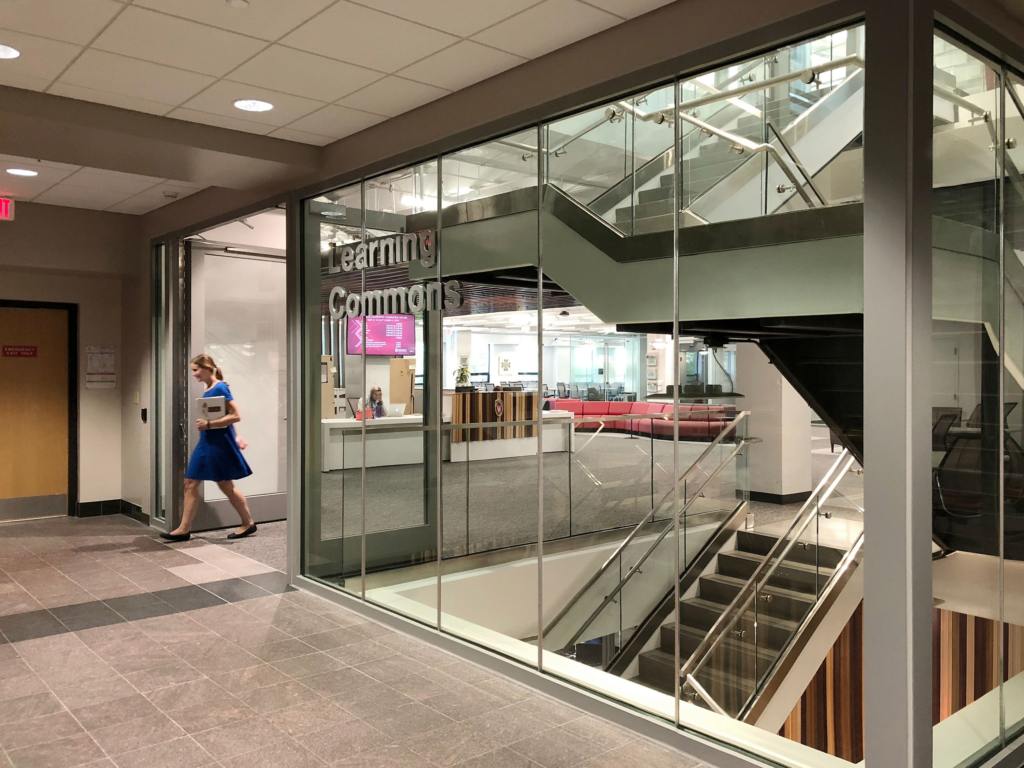Three Applications Transformed with Fire Rated Glass

Glass has long been used by architects to add vision, transparency, and a feeling of openness to an otherwise enclosed space. While the introduction of fire rated glass took it one step further by adding a life safety function on top of vision and transparency, the development of fire resistive glazing capable of meeting ASTM E-119/UL 263 gave architects the ability to design with glass like never before. Small fire rated doorlites and openings are transformed to wall-to-wall, floor-to-ceiling fire resistive transparent walls, full vision temperature rise doors and even fire resistive glass floors. Here are examples where this new breed of fire resistive glass has transformed how architects design and reimagine spaces – and they’ve never looked back since.
1. Stairwell Enclosures
This is perhaps where fire rated glass has had the most design impact in the last two decades. Traditionally, stairwells have had a more utilitarian function on a building. Required to meet the more stringent fire resistive wall standard for 1-2 hours because they perform specifics life safety functions in the event of a fire: a means for safe egress so building occupants can evacuate safely OR an area of refuge for occupants can wait for rescue if they cannot exit the building on their own. Before the development of fire resistive glazing that can meet the stringent ASTM E-119/UL 263 wall criteria, these stairwells were dark, closed off and away from view. They were seldom used because aside from being uninviting, the lack of vision into the space made stairwells a target for mugging, attacks, etc.
Today, architects using fire resistive glazing to make stairwells a design feature instead of being purely utilitarian. New advances in fire resistive glazing technology such as 1 and 2 hour clear, butt-glazed walls in large sizes added even more transparency and openness while still meeting the codes. Because these stairwells are full of light and vision, they seen more prominently in buildings and used more frequently by occupants.
 |
| The University of Wisconsin School of Business Learning Commons stairwell enclosure is designed with clear, fire resistive, butt-glazed walls using ASTM E-119/UL 263 rated SuperLite II-XLM with GPX Architectural Series perimeter framing. |
2. Glass Floors
Certainly, glass floors are not new – but fire resistive, 1 and 2 hour glass floors is still a novel idea. The reason being is that testing for fire resistive glass floors is grueling. The entire assembly (glass and frame) is tested to ASTM E-119/UL 263 with a load (typically 100 psf) applied to the assembly for the entire duration of the test. If the assembly remains intact and limits the temperature rise to less than 250 degrees F above ambient on the non-fire side, the assembly passes.
Designers use fire resistive glass floors the same way they would fire resistive glass walls: to bring natural light further into the building, or to maximize shared artificial lighting between floors. Not to mention, it provides a dramatic design statement to any space.
 |
| 1 hour fire resistive GPX FireFloor system at the 21C Museum and Hotel in Nashville. |
3. Lot lines
As mentioned, fire rated glass fulfills the designer’s goals of having unobstructed views and natural light. In cities like New York, Chicago, San Francisco or Boston where buildings are typically in close proximity to one another, designers can turn to fire rated glass to meet lot line requirements without sacrificing transparency. Because the building code considers fire resistive glazing that meets ASTM E-119/UL 263 as a wall instead of an opening a very important distinction it can be used in areas where exterior openings are not permitted all (typically between 0-3 feet of the lot line) or limited in size per IBC Table 705.8. By using fire resistive glass, designers don’t have to sacrifice expansive clear views and abundant natural light in order to meet code requirements.
 |
| Clear, unobstructed views of the New York City skyline are possible in zero lot line applications thanks to SuperLite II-XLB 120 in GPX Architectural Series framing. |